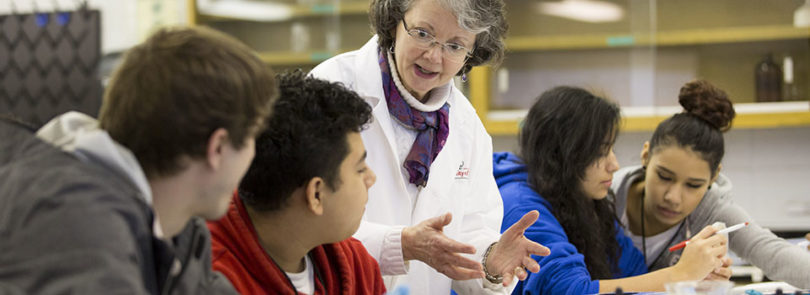More than 450 Clarke County high school students had the opportunity to take a look behind the curtain of university science in two recent STEM-focused trips to University of Georgia laboratories and research facilities.
Ninth-graders from Clarke Central and Cedar Shoals high schools each had a day to visit a variety of science learning environments, from plant, marine animal and pathology laboratories to greenhouse and electron microscope facilities.
The high school visits were part of Experience UGA, an initiative designed to give students hands-on, curricular-based learning activities and to foster interest in the pursuit of higher education among Clarke County students who might not otherwise consider college as a possibility. This particular ninth-grade trip aimed to increase students’ interests in the field of science, and was the second set of biology experience trips orchestrated in the last year by associate professor of microbiology Anna Karls. As evidenced by the reaction of some of the students, the program was a success.
During her visit to campus, Clarke Central student Katy Mayfield said she “uncovered a potential latent interest in science” because of her experience.
“I’m honestly not normally a particularly science-oriented person, but today’s trip really made me deeply consider majoring/interning in or going into a career in science, specifically biology.”
In addition to changing the lives of Clarke County students, the program is making a significant impact on current UGA students serving as tour guides and teachers.
Elizabeth Robinson, a senior from Lee County majoring in animal science, was one of 68 undergraduate students in Karls’ microbiology service-learning course that designed and supervised a clinical microbiology lab experience that had the high school students identify bacteria under a microscope.
“This experience is helping me to learn how to explain things in a simpler way,” said Robinson, who has aspirations of becoming a veterinarian. “It’s helping me to think about who our audience is. This will help me to talk to my clients in terms they will understand.”
Kristi Haisler, a senior from Marietta who is majoring in microbiology with a pre-dental focus, worked with students from Clarke Central and then as a tour guide for Cedar Shoals students who came two weeks later.
“I never had to teach anybody before this, so it was a good way to test what I know. They seemed interested in what we were doing. I had a couple of kids who asked me about being a scientist, and so it was great that I got to give advice to them.”
In addition to identifying bacteria and making scientific evaluations, the ninth-graders got the chance to handle sea crabs, look at magnified images as small as dust mites through an electron microscope and dissect insect-eating plants.
In assistant professor Andrea Sweigart’s plant genetics lab in the Riverbend greenhouse facilities, students gathered around groupings of plants and were asked to explain differences and similarities between the progeny of cross-pollinated plants. The session was led by UGA post-doctoral student Rachel Kerwin, who explained the how genetic traits in plants translates to genetic traits in humans.
“I was really impressed with how they listened to me, asked questions and observed the environment around them,” said Kerwin. “I would have loved to have had something like this when I was in high school.”
Mayfield summed up her visit by saying, “The biology building was fascinating. I never knew so many labs or beakers could fit in one building, and I felt a thousand times smarter simply by stepping into it, not to mention taking seminars from some great teachers-and students!”
Experience UGA is a partnership launched in 2014 between the Clarke County School District, UGA Office of Service-Learning, College of Education’s Office of School Engagement, and other units on campus. Nearly 10,000 students across eight grade levels in the Clarke County School District will have visited the UGA campus over 100 days this year.






